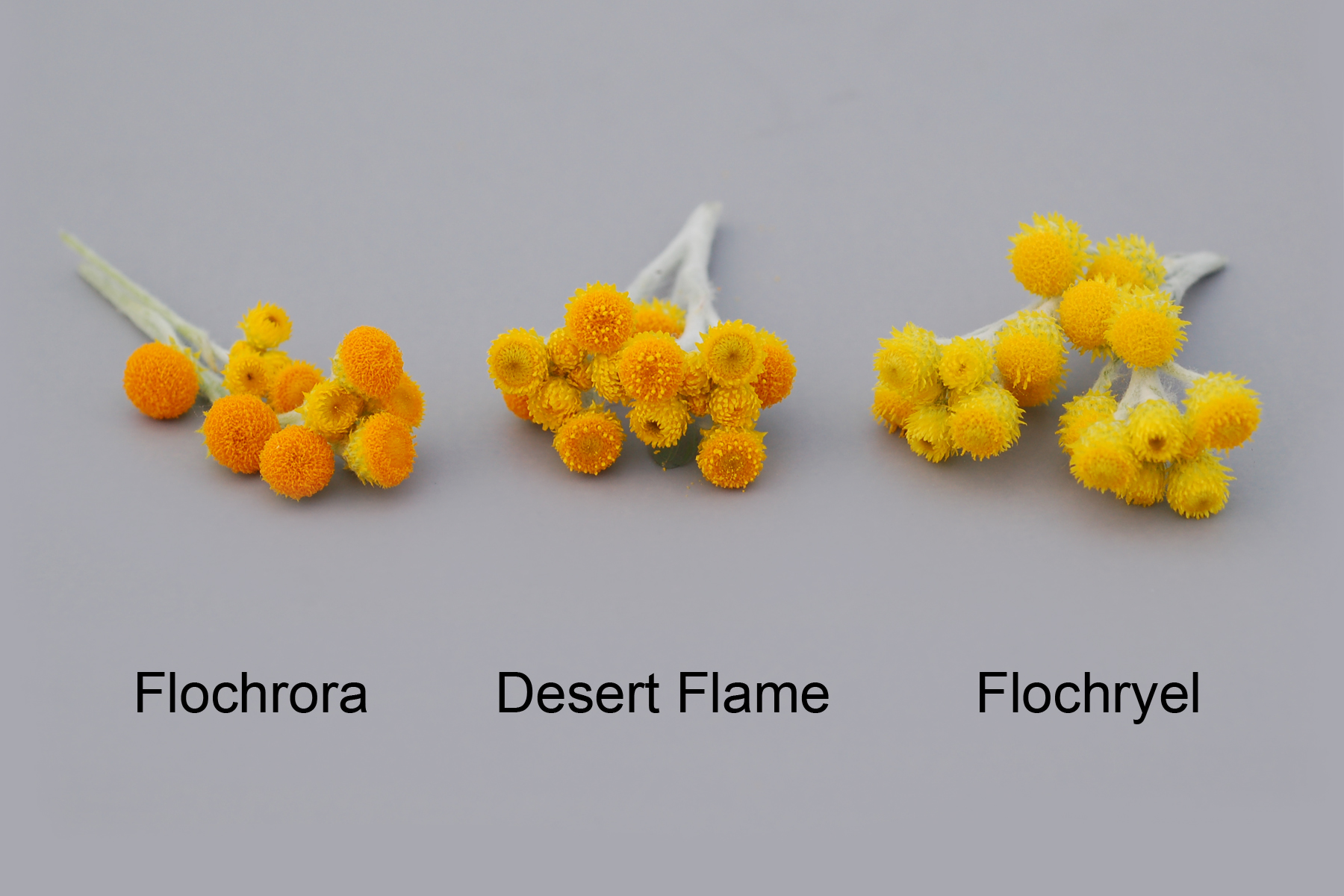Flochrora
| Denomination: | 'Flochrora' |
|---|---|
| Trade name: | Flambe Orange |
| Botanical Name: | Chrysocephalum apiculatum |
| Applicant/Holder: |
Floreta Developments Pty. Ltd. P.O. Box 7323 Redland Bay, Queensland 4165,99 Australia |
| Breeder: |
Kerry Veianne Bunker, Floreta Pty. Ltd., Redland Bay, Australia |
| Agent in Canada: |
BioFlora Inc. 38723 Fingal Line R.R. #1 St. Thomas, Ontario N5P 3S5 Canada Tel: 519-317-7511 |
| Application Date: | 2006-04-13 |
| Application Number: | 06-5431 |
| Grant of Rights Date: | 2008-08-29 |
| Certificate Number: | 3279 |
| Date rights surrendered: | 2011-09-22 |
Variety Description
Varieties used for comparison: 'Flochryel' (Flambe Yellow) and 'Desert Flame'
Summary: 'Flochrora' differs from the reference varieties mainly by plant height and width, density of foliage, flower head height and bract and disc colour. 'Flochrora' is taller and wider than the reference varieties. The foliage is less dense for 'Flochrora' than the reference varieties. 'Flochrora' has a shorter flower head height than the reference varieties. The bract colour of 'Flochrora' is a slightly darker yellow than 'Flochryel'. The disc colour after dehiscence for 'Flochrora' is more orange than the reference varieties which are a yellow orange.
Description:
PLANT: semi-upright to spreading growth habit, medium dense foliage
STEM: thin, moderately sericeous, long appressed hairs
LEAF: spatulate shape, rounded and cuspidate apex, attenuate base, medium green, medium pubescence on upper and lower sides (tomentose), absent or very weak anthocyanin on upper and lower sides
FLOWER: compound corymb inflorescence type, yellow bract before dehiscence, orange disc after dehiscence
Origin & Breeding History: 'Flochrora' is a product of a planned breeding program conducted by the breeder, Dr. Kerry Veianne Bunker, in Redland Bay, Queensland, Australia. 'Flochrora' originated from a cross conducted between the proprietary seedling identified as 02-036 as the female parent and the proprietary seedling identified as 02-037 as the male parent in September 2001. This variety was selected from the progeny of the above-stated cross for criteria based on compact plant habit, flower quantity and a long flowering period. Asexual reproduction by vegetative cuttings was first conducted in January 2002 at Redland Bay, Queensland, Australia.
Tests & Trials: PBR trials were conducted in a polyhouse during the summer of 2007 in St. Thomas, Ontario. Trials included 15 plants of the candidate and reference variety. Rooted cuttings were transplanted into 11.5 cm pots on May 10, 2007. Observations and measurements were taken from 10 plants of each variety on July 9, 2007. All colour measurements were made using the 2001 Royal Horticultural Society (RHS) Colour Chart.
Comparison tables for 'Flochrora' with reference varieties 'Flochryel' and 'Desert Flame'
Plant height (cm)
| 'Flochrora' | 'Flochryel' | 'Desert Flame' | |
|---|---|---|---|
| mean | 28.8 | 24.8 | 21.0 |
| std. deviation | 1.81 | 2.25 | 2.58 |
Plant width (cm)
| 'Flochrora' | 'Flochryel' | 'Desert Flame' | |
|---|---|---|---|
| mean | 56.6 | 48.7 | 38.6 |
| std. deviation | 5.82 | 4.42 | 2.67 |
Flower head height (mm)
| 'Flochrora' | 'Flochryel' | 'Desert Flame' | |
|---|---|---|---|
| mean | 6.3 | 7.4 | 7.5 |
| std. deviation | 0.48 | 0.52 | 0.53 |
Bract colour (RHS)
| 'Flochrora' | 'Flochryel' | 'Desert Flame' | |
|---|---|---|---|
| before dehiscence | 9A | 5A | 9A |
Disc colour (RHS)
| 'Flochrora' | 'Flochryel' | 'Desert Flame' | |
|---|---|---|---|
| after dehiscence | 25B | 14A | 23A |
Click on image for larger view

Chrysocephalum: 'Flochrora' (left) with reference varieties 'Desert Flame' (centre) and 'Flochryel' (right)
Click on image for larger view

Chrysocephalum: 'Flochrora' (left) with reference varieties 'Desert Flame' (centre) and 'Flochryel' (right)
- Date modified: